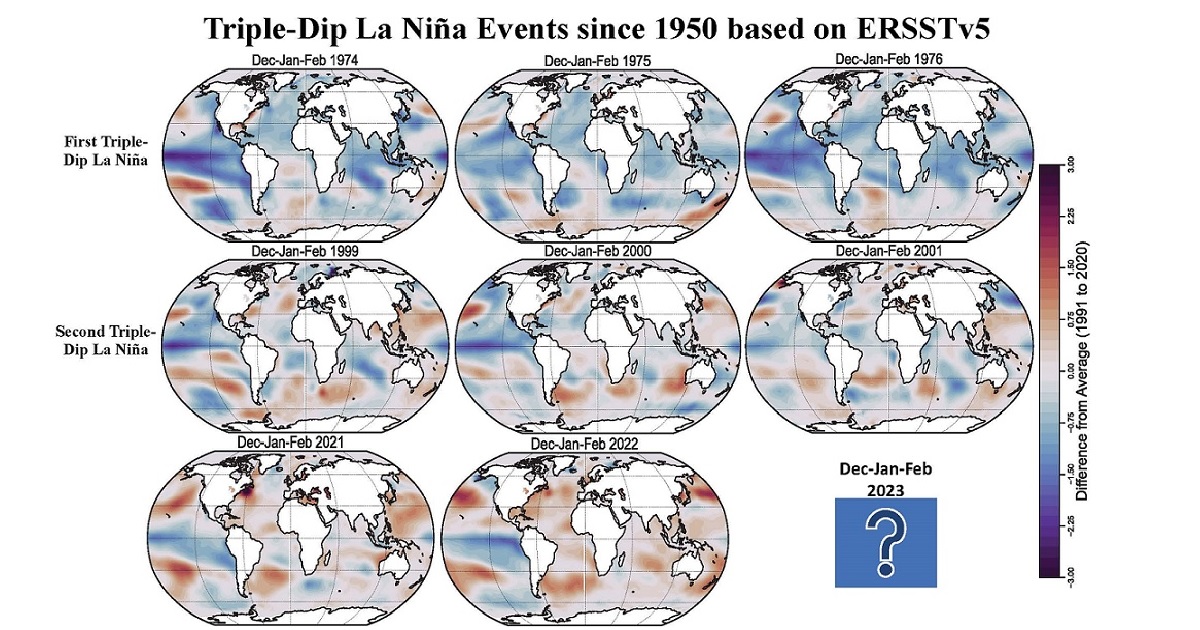Multi-Year ENSO Events: Dynamics, Predictability, Teleconnections, and Impacts
A special issue of Atmosphere (ISSN 2073-4433). This special issue belongs to the section "Climatology".
Deadline for manuscript submissions: closed (30 November 2023) | Viewed by 13933

Special Issue Editor
Interests: El Niño – Southern Oscillation (ENSO) dynamics and predictions; ENSO teleconnections; climate prediction from weeks to years; variability and predictability of the global monsoons and its relation to sea surface temperatures; regional climate variability and change; ENSO in warming climate; global ocean interactions
Special Issue Information
Dear Colleagues,
A multi-year La Niña, a cold phase of ENSO (El Niño Southern Oscillation), which began in the second half of 2020 is still ongoing. It is predicted that this La Niña event will last until the boreal winter of 2022-23 (as of August 2022), making it the first triple-dip event of the 21st century. Double-dipping is quite common, but three consecutive winters of La Niña are quite unusual. As ENSO is a major contributor to global climate variability from year to year, extreme climate events, which affect water resources, agricultural products, energy, food supply chains, transportation, and tourism among others, have a serious impact on the socio-economic world at large. Based on decades of research, Global ENSO forecasting capabilities are currently capable of forecasting ENSO several months in advance, with sufficient skill, however, gaps remain in our knowledge about ENSO, specifically with respect to the multi-year ENSO events.
This Special Issue entitled “Multi-year ENSO Events: Dynamics, Predictability, Teleconnections, and Impacts” seeks papers that provide further insight into the physical aspects of multi-year ENSO events, including the feedback processes, the role of the deep ocean, the atmosphere, the interactions between long-lasting ENSO events and other ocean basins like Indian and Atlantic Oceans, the predictability of multi-year events, and teleconnections. In this call, we are specifically looking for papers describing and highlighting how such long-lasting events could impact regional climates around the globe.
Dr. Muhammad Azhar Ehsan
Guest Editor
Manuscript Submission Information
Manuscripts should be submitted online at www.mdpi.com by registering and logging in to this website. Once you are registered, click here to go to the submission form. Manuscripts can be submitted until the deadline. All submissions that pass pre-check are peer-reviewed. Accepted papers will be published continuously in the journal (as soon as accepted) and will be listed together on the special issue website. Research articles, review articles as well as short communications are invited. For planned papers, a title and short abstract (about 250 words) can be sent to the Editorial Office for assessment.
Submitted manuscripts should not have been published previously, nor be under consideration for publication elsewhere (except conference proceedings papers). All manuscripts are thoroughly refereed through a single-blind peer-review process. A guide for authors and other relevant information for submission of manuscripts is available on the Instructions for Authors page. Atmosphere is an international peer-reviewed open access monthly journal published by MDPI.
Please visit the Instructions for Authors page before submitting a manuscript. The Article Processing Charge (APC) for publication in this open access journal is 2400 CHF (Swiss Francs). Submitted papers should be well formatted and use good English. Authors may use MDPI's English editing service prior to publication or during author revisions.
Keywords
- multi-Year ENSO events
- double-Dip El Nino and La Nina
- triple-dipping
- predictability
- teleconnections
- seasonal forecast
Benefits of Publishing in a Special Issue
- Ease of navigation: Grouping papers by topic helps scholars navigate broad scope journals more efficiently.
- Greater discoverability: Special Issues support the reach and impact of scientific research. Articles in Special Issues are more discoverable and cited more frequently.
- Expansion of research network: Special Issues facilitate connections among authors, fostering scientific collaborations.
- External promotion: Articles in Special Issues are often promoted through the journal's social media, increasing their visibility.
- Reprint: MDPI Books provides the opportunity to republish successful Special Issues in book format, both online and in print.
Further information on MDPI's Special Issue policies can be found here.





